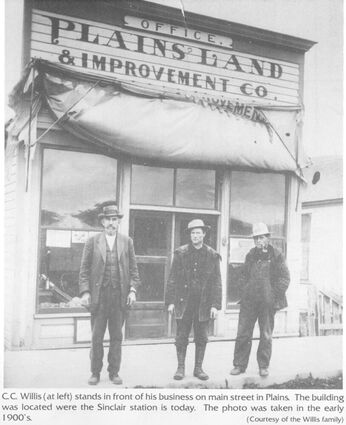Remember When?
November 11, 2021
40 YEARS AGO • OCTOBER 8, 1981
MANY CHANGES OCCUR IN PLAINS' CENTURY
by Lenora Brown
With the Plains Centennial Celebration coming up, this reporter came out of a recent Chamber of Commerce meeting, looked up and down Main Street and tried to picture just what Wild Horse Plains was like 100 years ago.
Here is the beautiful Clark Fork River running past town. Here are the railroad tracks where the wild horses used to roam. What was it like to come into town just after the railroad tracks were laid? To come from Columbus Missouri with your wife and two sons to become the first attorney in Plains?
Imagine John Willis, who had the first store in Thompson Falls, writing to his brothers so long ago to come. At that time it was possible to get two boxcars, one for the beds, cook stove and furniture and the other for animals. Charles C. Willis decided this was what he was going to do. So did another brother, Jim Willis. What about these pioneering women that came with their men? Just how were they going to live until their homes were built? There was a beautiful river running between two batches of mountains. There were plenty of horses. What did they eat before their gardens were up? What did they do for help?
Charles C. and Mary Willis and sons Alvin and Clarence, and James and Iris Willis started their lives among the Native Americans. It wasn't too long before others joined them. Here to meet them and help were the Lynch family, of which Ruth Lynch Stearns is a descendant.
The first house Charles Willis built is the one now standing on Main St. in Plains as the pioneer schoolhouse. Then after they had that to live in, they started the ranch home below the present feed mill on First Avenue. The house was then turned into the schoolhouse to have a place to educate his family. Since coming to Plains, two boys and a girl, Charles M., Myra and Willard were born. Mary Willis was not well and passed away when Charles M. was but four years old. The family was assisted by Sadie Cave from the Ozarks of Missouri. She had come to visit Mr. and Mrs. Hugh Stevens, relatives, but remained to become the second Mrs. Willis.
Mr. and Mrs. Jim Willis built a ranch home across the tracks from Charles' home, but further out in the valley. Jim was killed on the land by a runaway team. His wife, Iris, remained here in Plains until her death and is buried in the Plains Cemetery beside her husband.
What did these people see in Plains to keep them for 100 years? As John Rhone has stated in "Wild Horse Plains," "no oiled highways, no stop signs, no cars or trucks and no electric lights or water to be obtained by turning a faucet."
As John remembers it, "Farthest west on the Main Street was the schoolhouse which in later years was moved to the present site, enlarged and modernized to become the Tourist Hotel. This school had been built very recently to replace the school which was a small log building on the Charles Willis ranch about a mile west of Plains. The pupils got their drinking water from a pail of water carried in each morning and drank from a dipper hanging on the wall by the pail. The janitor work was done by two schoolboys.
"Then on the site where the Tourist Hotel now stands was the newly built Plainsman newspaper office. This building had the newspaper equipment in the front and in the rear were the Rhone living quarters. My dad purchased three acres upon his arrival in Plains, and in addition to the printing office building, had erected a barn on the rear of the three acres to accommodate a milk cow."
"Directly east of the Plainsman building was the Mercantile establishment of H.A. Hammon and Sons. Before long the log building was replaced by the concrete building that was there at that time. The Hammon firm was a true product of the old rugged west and refused to be budged by the McGowan set-up. As was customary in those days, competition was not tolerated by the big shots. This was true from the big Anaconda Company down through the range cattle outfits to the smallest businessmen. However, the Hammons seemed to prosper and in later years branched out to establish stores in Camas Prairie and Hot Springs.
"The McGowan Hotel was located east of the Hammon Store and was the only hostelry at that time. The post office was located in this building and presided over by an old maid who seemed to have a dim outlook on life.
"The big building of the J.A. McGowan store came next, and this in addition to the other enterprises was under the supervision of C.H. Rittenout, R.A. Reunaver, and F.M. Lewellen.
"Further east were the saloons of Tony Zebish and W.A. Burrill and the drugstore of C.H. Lebcher, who also was the only physician in that vicinity."
Across the railroad tracks was the Monpetit Blacksmith Shop. Monpetit was a Frenchman who "was an artist in his line of work and with shoeing horses and regular blacksmith work."
Then across the tracks was the section house where Louis Ostlie, section foreman and his family, made their home for many years. In addition were various residences scattered around the new town, none very pretentious; and in comparison to the Plains of today, quite primitive.
Picture these placed on the Main Street with hitching posts in front of every establishment and teams and saddle horses tied up waiting for their owners to drive or ride home, and for some whose owners were in the saloons, it was quite a wait, and you have a vague picture of Main Street in 1900.









Reader Comments(0)